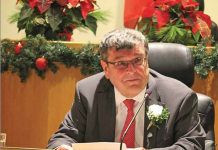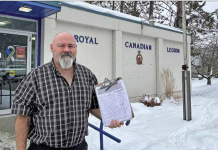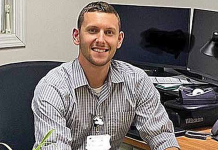It’s a frosty morning as genealogist Adele Espina climbs out of her pick-up truck on one of the internal roads at Evergreen Cemetery in Haliburton.
She knows exactly where she is going thanks to cemetery records.
She stops at one gravesite, marked only with a small Canadian flag she had placed there the day before. No gravestone. But that is something Espina is working to rectify.
Her research has unearthed that the man buried beneath her feet is Harry Adams, who served with the 109th Battalion in the First World War. Adams was born in 1864 in England, but moved to Canada. He enlisted at the age of 50, giving a false birth year, and died in 1948 at the ripe old age of 84.
He is buried in a McKnight family plot, since his last wife was a McKnight. For some reason, perhaps financial, there was never a marker of any sort erected.
Espina has found out quite a lot about Adams, partially through Ancestry.com, including that he married three times. She later opens a folder over a hot drink at Castle Antiques in Haliburton and reveals gems such as service records, death certificate, and photos of Adams with his regiment taken outside the Dysart et al municipal office and elsewhere.
She has submitted the necessary paperwork to the Last Post Fund, a national non-profit organization that provides grave markers for veterans. Espina said it might take a couple of years before Adams gets his.
‘Who more to be remembered than our veterans’
The genealogist estimates there are approximately 50 veterans requiring grave markers across Haliburton County. She’s on a quest to get them all one.
“There’s plenty of soldiers or veterans who are buried here and do have military markers…and a lot of family markers that veterans are attached to, and then there are veterans who, for whatever reason, slipped through the cracks and have no monuments whatsoever,” Espina says while standing at Adams’ grave.
Espina said part of her niche in the Haliburton Highlands Genealogy Group is cemeteries. She has access to burial maps. She jokes there is a name for that: taphophile; a person who loves cemeteries, gravestones, and funerary art and history.
“Well, I don’t think any of us want to be forgotten … and who more to be remembered than our veterans,” she says of her journey.
For each vet she researches, she builds a tree on Ancestry.com and gathers all the information she can. She’s also now using the recently-released Haliburton Highlands Digital Archives of newspapers. “I’ve just been vacuuming up any details that I can find and it’s been helpful.”
Her dad was in the Royal Canadian Air Force in the Second World War, seconded to the U.K.’s Royal Air Force, just 19 when he went on his first bombing mission.
Her maternal grandfather had been with the Canadian Expeditionary Force in the First World War, but never got to France, as he came down with the Spanish flu, but recovered, and worked in a hospital. Library and Archives Canada have records of him, right down to his sickness temperatures. Her daughter went to Royal Military College, serving as a combat systems engineer in the Navy before going to medical school.
Espina’s interest began when she worked for the Minden Museum, on a sesquicentennial project, looking into military personnel records. She came up with over 500 people in Haliburton County who were born in the Highlands and served, or lived there and served. She did an exhibit at the cultural centre in 2009. “I plastered the walls of the Welch room … with all their attestation papers and the exhibit was really well received. That’s what got me going on the people who had served.”
She talks about a vet who had a military grave marker until 1991, but it’s gone now. “So, I can get him another one.” All she has to do is prove the person is dead, buried in that particular cemetery, and that they served in the military.
She added, “this is something concrete that I can do. I think the reward for me will be the day that those markers are put up.”





